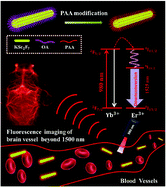Our official English website, www.x-mol.net, welcomes your
feedback! (Note: you will need to create a separate account there.)
A high performance Sc-based nanoprobe for through-skull fluorescence imaging of brain vessels beyond 1500 nm†
Nanoscale ( IF 5.8 ) Pub Date : 2018-04-25 00:00:00 , DOI: 10.1039/c8nr00305j Zhiming Deng 1, 2, 3, 4, 5 , Xiaolong Li 1, 2, 3, 4, 5 , Zhenluan Xue 1, 2, 3, 4, 5 , Mingyang Jiang 1, 2, 3, 4, 5 , Youbin Li 1, 2, 3, 4, 5 , Songjun Zeng 1, 2, 3, 4, 5 , Hongrong Liu 1, 2, 3, 4, 5
Nanoscale ( IF 5.8 ) Pub Date : 2018-04-25 00:00:00 , DOI: 10.1039/c8nr00305j Zhiming Deng 1, 2, 3, 4, 5 , Xiaolong Li 1, 2, 3, 4, 5 , Zhenluan Xue 1, 2, 3, 4, 5 , Mingyang Jiang 1, 2, 3, 4, 5 , Youbin Li 1, 2, 3, 4, 5 , Songjun Zeng 1, 2, 3, 4, 5 , Hongrong Liu 1, 2, 3, 4, 5
Affiliation

|
Optical bioimaging that works in the second near infrared region (NIR-II, 1000–1700 nm) has emerged as a next generation imaging technique with superior imaging sensitivity and spatial resolution compared to traditional optical imaging utilizing visible and near-infrared lights (below 900 nm). Herein, a new Sc-based NIR-II probe was explored for high performance NIR-II in vivo bioimaging and optical imaging-guided non-invasive brain blood vessel visualization. The lanthanide doped Sc-based probes (KSc2F7:Yb3+/Er3+) possess a pure orthorhombic phase structure with size control by adjusting the F− ion content. These probes present a dominant red upconversion (UC) emission, which is significantly different from the traditional NaYF4:Yb/Er host, which usually has a green UC emission. More importantly, apart from the dominant red UC emission, these probes also possess a strong NIR-II downconversion (DC) emission centered at 1525 nm, which is usually ignored for bioimaging applications. In vivo NIR-II imaging reveals that our explored Sc-based nanorods are promising probes for highly sensitive optical imaging. Moreover, non-invasive through-skull fluorescence bioimaging of brain vessels with high spatial resolution was demonstrated. Therefore, it is expected that Sc-based nanomaterials with unique dominant red UC and DC NIR-II emissions beyond 1500 nm are ideal probes for bio-applications.
中文翻译:

一款基于Sc的高性能纳米探针,可对1500 nm以上的脑血管进行全颅荧光成像†
在第二近红外区域(NIR-II,1000-1700 nm)中工作的光学生物成像技术已成为下一代成像技术,与传统的利用可见光和近红外光(低于900的光学成像)相比,它具有更高的成像灵敏度和空间分辨率。纳米)。在这里,新的基于Sc的NIR-II探针被探索用于高性能NIR-II体内生物成像和光学成像引导的非侵入性脑血管可视化。镧系元素掺杂的基于钪探针(KSC 2 ˚F 7:镱3+ / ER 3+)通过调节在F具有与尺寸控制纯正交相结构-离子含量。这些探针呈现显性的红色上转换(UC)发射,这与通常具有绿色UC发射的传统NaYF 4:Yb / Er宿主显着不同。更重要的是,除了主要的红色UC发射之外,这些探针还具有以1525 nm为中心的强NIR-II下转换(DC)发射,通常在生物成像应用中会被忽略。体内NIR-II成像表明,我们探索的基于Sc的纳米棒是用于高灵敏度光学成像的有前途的探针。此外,证明了具有高空间分辨率的脑血管的非侵入性贯穿颅骨荧光生物成像。因此,可以预期具有独特的显着红色UC和DC NIR-II发射超过1500 nm的Sc基纳米材料是生物应用的理想探针。
更新日期:2018-04-25
中文翻译:

一款基于Sc的高性能纳米探针,可对1500 nm以上的脑血管进行全颅荧光成像†
在第二近红外区域(NIR-II,1000-1700 nm)中工作的光学生物成像技术已成为下一代成像技术,与传统的利用可见光和近红外光(低于900的光学成像)相比,它具有更高的成像灵敏度和空间分辨率。纳米)。在这里,新的基于Sc的NIR-II探针被探索用于高性能NIR-II体内生物成像和光学成像引导的非侵入性脑血管可视化。镧系元素掺杂的基于钪探针(KSC 2 ˚F 7:镱3+ / ER 3+)通过调节在F具有与尺寸控制纯正交相结构-离子含量。这些探针呈现显性的红色上转换(UC)发射,这与通常具有绿色UC发射的传统NaYF 4:Yb / Er宿主显着不同。更重要的是,除了主要的红色UC发射之外,这些探针还具有以1525 nm为中心的强NIR-II下转换(DC)发射,通常在生物成像应用中会被忽略。体内NIR-II成像表明,我们探索的基于Sc的纳米棒是用于高灵敏度光学成像的有前途的探针。此外,证明了具有高空间分辨率的脑血管的非侵入性贯穿颅骨荧光生物成像。因此,可以预期具有独特的显着红色UC和DC NIR-II发射超过1500 nm的Sc基纳米材料是生物应用的理想探针。










































 京公网安备 11010802027423号
京公网安备 11010802027423号